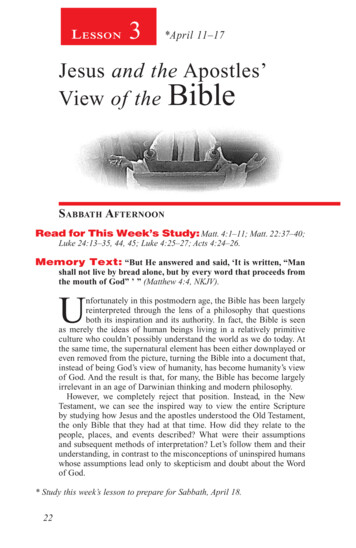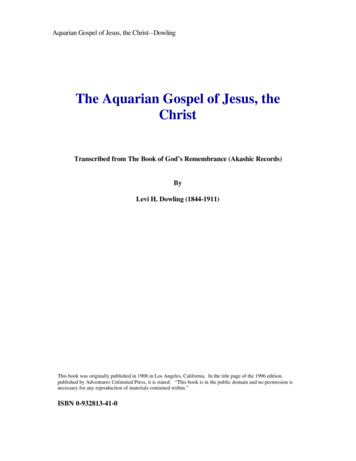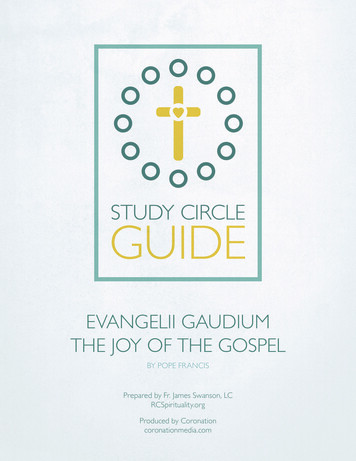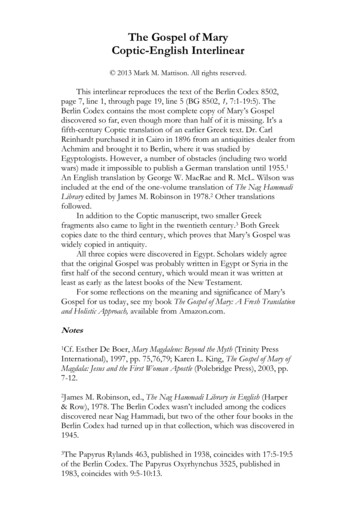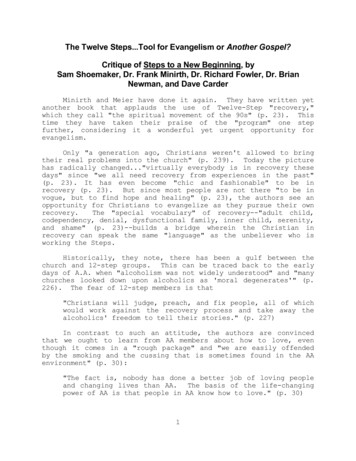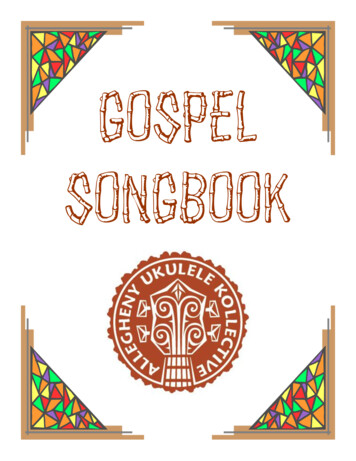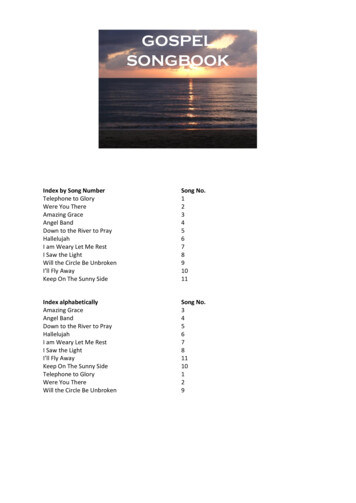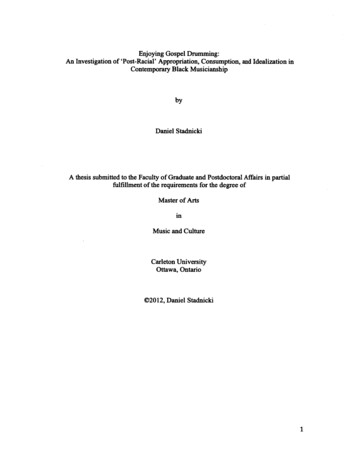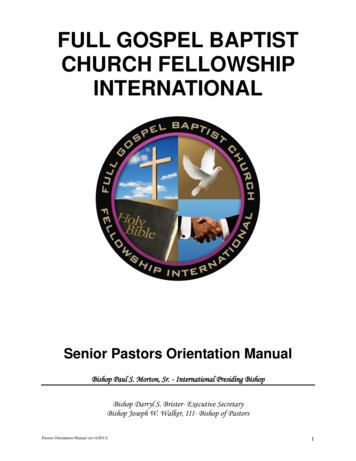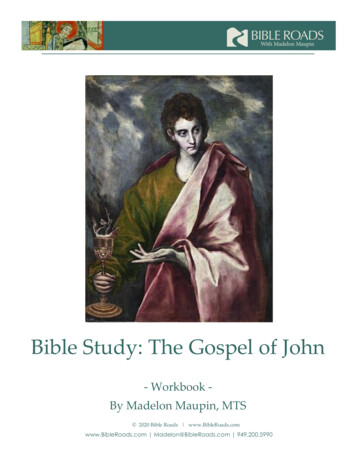
Transcription
Bible Study: The Gospel of John- Workbook By Madelon Maupin, MTS 2020 Bible Roads www.BibleRoads.comwww.BibleRoads.com Madelon@BibleRoads.com 949.200.5990
CopyrightThank you for purchasing this workbook from Bible Roads. Please visitwww.BibleRoads.com for more information about videos, webinars,audio lectures, ebooks, articles, workbooks, and live events covering avariety of Bible study topics with Madelon Maupin.This publication is copyrighted, thus it may not be reproduced ortransmitted, in any form, or by any means (electronic, photocopying, orotherwise), without the prior written permission of Bible Roads. ForBible Study groups, each individual participant needs to purchase theirown workbook. Thank you for honoring this copyright request.Cover image: “St. John the Evangelist”, El Greco, MadridMost Biblical quotations are from The Holy Bible: The NewRevised Standard Version. (1989) Nashville: Thomas NelsonPublishers.This book belongs to2 2020 Bible Roads www.BibleRoads.com
Table of ContentsBiography . . . . . . . . . . . . . . . . . . . . . . . . . . . . . . . . . . . . . . . .5Bible Study Guidelines . . . . . . . . . . . . . . . . . . . . . . . . . . . . . . . 6Bible Translations . . . . . . . . . . . . . . . . . . . . . . . . . . . . . . . . . . .8Introduction to The Gospel of John . . . . . . . . . . . . . . . . . . . . . 10Chapter 1. . . . . . . . . . 12Chapter 11 . . . . . . . . . . 32Chapter 2. . . . . . . . . . 14Chapter 12 . . . . . . . . . . 34Chapter 3. . . . . . . . . . 16Chapter 13 . . . . . . . . . . 36Chapter 4. . . . . . . . . . 18Chapter 14 . . . . . . . . . . 38Chapter 5. . . . . . . . . . 20Chapter 15 .40Chapter 6. . . . . . . . . . 22Chapter 16 . 42Chapter 7. . . . . . . . . . 24Chapter 17 44Chapter 8. . . . . . . . . . 26Chapter 18 . . . . . . . . . . 46Chapter 9. . . . . . . . . . 28Chapter 19 . . . . . . . . . . 48Chapter 10 . . . . . . . . . . 30Chapter 20 . . . . . . . . . . 50Chapter 21 . . . . . . . . . . . 52Your Insights about John . . . . . . . . . . . . . . . . . . . . . . . . . . . . . 54 2020 Bible Roads www.BibleRoads.com3
4 2020 Bible Roads www.BibleRoads.com
BiographyMadelon has a Master of Arts in Theological Studies(with an emphasis on Biblical Studies) from San Francisco Theological Seminary. She received a certificatefrom The Balkan Institute, Thessalonica, Greece, forstudies in Greek language and culture, and haslectured extensively for Princess Cruises as theirship’s Cultural Historian for cruises to the MiddleEast as well as Europe and the UK. Madelon closedan active leadership consulting firm based in Southern California in 2011 after twenty wonderful yearsworking with senior executives.Madelon now enjoys sharing her love of the Biblethrough talks on a variety of Biblical books and subjects for churches and organizations throughout theworld. She does this through her company, BibleRoads, dedicated to providing Biblical educationthrough a wide variety of online courses, workbooks,webinars and CD’s and MP3 versions of talks. Herwebsite (www.BibleRoads.com) also has a number offree resources for Bible Study for both individualsand groups.Sharing the Bible with young people is a specialinterest and Madelon has been privileged to provideBible workshops at Church Youth Summits as well asserving Adventure Unlimited/DiscoveryBound as amember of its Board of Trustees.Map on opposite pageby Katherine Baxter.comShe lives in Newport Beach, California, with herhusband, George Birdsong, serves on the Faith andOrder Commission of Southern California and was aTrustee of the New Theological Seminary of the West.Madelon is also a member of her church’s NationalEcumenical Team. 2020 Bible Roads www.BibleRoads.com5
Bible Study GuidelinesWays to approach Bible study1. Choose a Bible Book: Select a book (or letter) of the Bible you would like tostudy, and read it chapter by chapter, perhaps with one member of the groupwriting questions ahead for each member to answer and share. Or find a BibleStudy workbook, such as those Bible Roads produces, that already has studyquestions for you. Consider how often you will meet and where. I wouldrecommend no more than one chapter per hour of discussion or you might begoing too fast to really cover it all. (See “Ways to Approach a Discussion in aGroup Setting,”, pg. 7)2. Select a Theme: Take a theme such as found in Luke 24 as Jesus is walking toEmmaus. When he gives the two men a Bible lesson in references to him in theOld Testament, look those up and share your findings with your study group.3. Study Chronologically: Begin with the various groups of biblical figures that gotogether, such as the Patriarchs in the Torah; the Major Prophets (Isaiah, Jeremiah, Ezekiel); the Minor Prophets (Amos, Hosea, etc.); the Kings of Israel, theKings of Judah, or the fall of each kingdom and deportations; the return toJerusalem; Paul’s letters; the pastoral letters; etc.4. Select Characters: Joseph’s life story, David, Jesus, Paul, etc.5. By a Book or Certain Characteristics: Distinctions between the Gospels; Book ofJohn, women characters, teenagers in the Bible, or words such as light, grace,promise, etc.Ways to make the Bible your own1. Memorize a Psalm, or verses regularly.2. Study in a contemporary or idiomatic translation.3. Commit to reading four pages a day (or any one year reading program).4. Commit to reading a favorite Biblical book each month.5. Use a good atlas, tracing journeys, understanding topography.6 2020 Bible Roads www.BibleRoads.com
Ways to do Bible Study Individually or with a Group1. After reading a chapter, give it a title.2. Select your favorite verse from the chapter and/or one that reflects the theme.3. Identify an idea that is meaningful to you and explain why. Explain how youwould “pull it forward”, that is apply that verse to your life today.4. Make a note of anything that is confusing or not understood clearly.5. Write a summary of your favorite passage in light of the whole chapter.Ways to Approach a Bible Study Discussion in a Group Setting1. After you determine which Bible book your group will study and how often youwill meet (1x/month, 2x/month, etc.), select someone as facilitator and possiblyrotate that role each time.2. Use Bible Roads or another workbook to provide study questions chapter bychapter. Send those out ahead to give shape to each person’s study.3. Read 1-2 verses aloud, going around the circle and announcing from which translation you’re reading. You might want to repeat the verses in another translation ifit’s helpful. Share what you learned about these verses or what came to you.4. Summarize the overall theme of the chapter either at the beginning or the end togive a “30,000-foot” view to capture the big themes.Bible OrganizationBible: A library of 66 books (‘biblia’ book); 2 Testaments, both in 4 parts.Old Testament (39 books) The Law, or Pentateuch - (1st 5 books, Genesis to Deuteronomy) History – (12, Joshua to Esther) Poetry, Wisdom - (5, Job to Song of Solomon) Prophesy – (17, Isaiah to Malachi)New Testament (27 books) Gospels (4 books, Matthew to John) History (1 book, Acts) Letters (21 books, Romans to Jude) Revelation (1 book, Revelation) 2020 Bible Roads www.BibleRoads.com7
Bible Translations - Brief DescriptionsAmplified Bible—By using synonyms and definitions in this translation, a word is amplified by placing the extended meanings in parentheses. This allows readers to gain a fullersense of the meaning of each verse. It is one of the few translations done by a woman,Frances Siewert (1881-1967) and published by The Lockman Foundation in 1987. Samplefrom John 11:25— Jesus said to her, “I am the Resurrection and the Life. Whoever believes in(adheres to, trusts in, and relies on) Me, [as Savior] will live even if he dies.”The Common English Bible (CEB) - A bold new translation designed to meet the needsof a broad range of people and written at a 7th grade reading level, thus known for its accessibility. It was prepared by a robust cross section of translators from 24 denominationsin 2010. Jesus said to her, "I am the resurrection and the life. Whoever believes in me will live, eventhough they die.The King James Version (KJV) — Translated in 1611 by 47 male scholars using the Byzantine family of manuscripts, Textus Receptus. This remains as a beloved version of the Bibledue to its majestic language and sweeping poetry and prose. It has been the most reliabletranslation for over three centuries, but its Elizabethan style Old English is difficult formodern readers, especially youth. More contemporary translations have addressed theKJV’s mistranslation due to increases in scholarship and awareness of early manuscriptsafter the 20th century discoveries of the Dead Sea Scrolls and Nag Hammadi finds. Jesussaid to her, “I am the resurrection and the life. He who believes in me, though he may die, he shalllive.The New King James Version (NKJV) — 130 translators, commissioned by Thomas Nelson Publishers, produced this version from the Byzantine family (Textus Receptus) in1982. This is a revision of the King James version, updated to modern English with minortranslation corrections and retention of traditional phraseology, but with an effort to havemore inclusive gender references. Jesus said to her, “I am the resurrection and the life. He whobelieves in Me, though he may die, he shall live.The Message Bible – This popular and paraphrased translation by Eugene Peterson, himself both a Hebrew and Greek language scholar, was written to help this former pastorcommunicate the vitality and directness of Scripture he felt parishioners weremissing. Peterson explains: “Writing straight from the original text, I began to attempt tobring into English the rhythms and idioms of the original language.” Published in 2002 byNavPress, The Message is popular with every educational level. “You don’t have to wait forthe End. I am, right now, Resurrection and Life. The one who believes in me, even though he or shedies, will live. And everyone who lives believing in me does not ultimately die at all. Do you believethis?”8 2020 Bible Roads www.BibleRoads.com
The New International Version (NIV) — Over 100 translators completed this work in1978 which was composed from Kittle’s, Nestle’s and United Bible Society’s texts, whichinclude the Alexandrian Family codices. This is considered an “open” style translation. Itis a good, easy to read version often favored by evangelical Christians. Jesus said to her, “Iam the resurrection and the life. The one who believes in me will live, even though they die;The New Living Translation (NLT) - Their translators faced the challenge to create a textthat would make the same impact in the life of modern readers that the original text hadfor original readers. In the New Living Translation, this is accomplished by translating entire thoughts (rather than just words) into natural, everyday English. The end result is atranslation that is easy to read and understand and that accurately communicates themeaning of the original text. Jesus told her, “I am the resurrection and the life. Anyone who believes in me will live, even after dying.The New Revised Standard Version (NRSV) – The most widely ‘authorized’ byProtestant churches, the NRSV was published in 1989 and stands out among many translations. It is highly recommended for use in most Christian seminaries and college classestoday because of its scholarship. Its translation committee consists of 30 men and womenamong America’s top scholars, representing a broad range of Protestant denominations aswell as Roman Catholic, Greek Orthodox and Jewish scholars. The Harper Collins StudyBible Edition is known for its outstanding study notes, including excerpts from the recently discovered Dead Sea Scrolls.Jesus said to her, “I am the resurrection and the life. Those who believe in me, even though they die,will live.J.B. Phillips New Testament—J.B. Phillips (1906-1982) was a well-known Anglican whowas committed to making the message of truth relevant to today’s world. This translationwas originally begun for his youth group within the Church of England and later published because of popular demand. Published by HarperCollins 1962. I myself am the resurrection and the life,” Jesus told her. “The man who believes in me will live even though he dies,and anyone who is alive and believes in me will never die at all. Can you believe that?”The Voice— Step into the Story of Scripture — This new translation is a dynamic equivalent one, similar to The Message. It is intended to be read like a story, yet with all the wisdom of God’s Word. The Voice works to invite the reader into the whole story of God andcreation. While it encourages readers to have a knowledge of God, The Voice is moreabout developing a personal relationship with God. This translation is intended for thosenew to the Scriptures with the intention that the idioms used in translation will make theentrance into the Bible more seamless. “I am the resurrection and the source of all life; thosewho believe in Me will live even in death.” 2020 Bible Roads www.BibleRoads.com9
Introduction to The Gospel of JohnYou will discover as you study this Gospel that it is quite distinct from Matthew, Markand Luke (also referred to as the synoptic Gospels, because of their similarity with one another). While the first three Gospels focus on what Jesus said and did, the Gospel of Johnis more concerned with Christ Jesus’ identity, who he IS. Also this Gospel shows Jesus’ministry to be three years, while the Synoptic Gospels collapse his activity into a singleyear.This Gospel is divided into two parts:A) The Book of Signs (John 1:19 —12:50)B) The Book of Glory (13:1 – 20:31)The first part of John illustrates the theme from the Prologue in 1:11: “To his own hecame; yet his own did not accept him.” While there is a focus on the different types ofpeople that come to believe in Jesus (“believe” is a key word throughout this Gospel), thereader also sees the hatred and resistance by “the Jews”. In this first section Jesus’ identity is starting to be revealed as the Lamb of God, the Son of God, “one sent by God”, etc.Watch for those hints throughout the first twelve chapters.The term “signs” is used throughout John as another term for “miracle”. There are sevendistinct signs that further identify the “far greater things” that Jesus , as the Son of Man(which he calls himself) will do.This Gospel also uses a series of long dialogues to make its theological and narrativepoints, such as the first one of Nicodemus comes to Jesus at night. (See 3:1-21). Themes aredeveloped in multiple consecutive chapters such as chapters 5—10 about light and Ch.8—10 about life.The Gospel author helps the reader by a pattern of miracle followed by dialogue (to helpexplain the ‘miracle’.) An example is the healing of the lame man on the sabbath in John5:1-47, followed by a dialogue that challenges theological tradition. Jesus continually refers to God as his Father, claiming a level of divinity that engenders hatred from religiousleaders.Closing the first Book of Signs, is the raising of Lazarus, acting as a bridge text to Jesus’own glorification which comes in the final section, the Book of Glory. The irony is that thisdemonstration of life is the very thing that makes the Sanhedrin (Jewish leaders) decide tokill Jesus.John 13:1 not only opens the second book but tells its theme: “Jesus knew that his hourhad come.” He knew he had to depart those he had so loved in this world and the fivechapters describing the Last Supper in this portion of the Gospel testify to Jesus’ deep lovefor his own. Rather than words at the Eucharist meal of bread and wine, as in the synopticGospels, Jesus teaches with his actions of washing the disciples’ feet. He will indeed “lovethem to the end.” (13:1)10 2020 Bible Roads www.BibleRoads.com
Absolute “I AM” sayings without a predicate nominative:4:26Jesus said to her, “I AM, the one who is speaking to you.”6:20But he said to them, “I AM; do not be afraid.”8:24“I told you that you would die in your sins, for you will die in your sins unless youbelieve that I AM.”8:28“When you have lifted up the Son of Man, then you will realize that I AM, and I donothing on my own, but I speak these things as the Father instructed me.”8:58“Very truly, I tell you, before Abraham was, I AM.”13:19 “I tell you this now, before it occurs, so that when it does occur, you may believethat I AM.”18:5, 7 Jesus replied, “I AM.” When he said to them, “I am,” they stepped back and fell tothe ground.“I AM” sayings with a predicate nominative:6:35“I am the bread of life. Whoever comes to me will never be hungry, and whoeverbelieves in me will never be thirsty.”6:51“I am the living bread that came down from heaven. Whoever eats of this breadwill live forever; and the bread that I will give for the life of the world is my flesh.”8:12“I am the light of the world. Whoever follows me will never walk in darkness butwill have the light of life.”9:5“I am the light of the world.”10:7, 9 “Very truly, I tell you, I am the gate for the sheep.”10:11, 14“I am the good shepherd.”11:25–6“I am the resurrection and the life.”14:6“I am the way, and the truth, and the life.”15:1, 5 “I am the true vine, and my Father is the vinegrower.”O’day, G. R. (1994–2004). The Gospel of John. In L. E. Keck (Ed.), New Interpreter’s Bible(Vol. 9, p. 602). Nashville: Abingdon Press. 2020 Bible Roads www.BibleRoads.com11
Chapter 1 - Questions“In the beginning was the Word, and the Word waswith God, and the Word was God.“ (1:1)1. How would you summarize the Prologue of this Gospel (vs. 1—18)?2. What does John mean by the “Word”?3. How does this Gospel’s beginning differ from the other 3 (Matthew, Markand Luke)?4. What is the relationship between the Logos and the concept of ‘believe’?5. How and where do you see one of this gospel’s underlying themes of ‘eternallife’ beginning to develop right from the beginning of this Gospel?12 2020 Bible Roads www.BibleRoads.com
Chapter 1 - Notes“Adoration of the Children”Gerard (Gerrit) van Honthorst(1590-1656) 2020 Bible Roads www.BibleRoads.com13
Chapter 2 - Questions“His mother said to the servants, ‘Do whatever he tells you.’ (2:5)1. What title would you give this chapter in terms of an overarching theme?2. What was John’s purpose for this story of the water turned into wine, especially since it is only in this Gospel, and particularly as the first ‘sign’?3. What is the role of Mary in the story and what are you learning about her(from this Gospel) so far?4. Where is the cleansing of the Temple story in any of the other Gospels? If it isdifferent from where John has placed it, what do you think is the author’sintention for doing so?5. What is the relation between belief and seeing ‘signs’?14 2020 Bible Roads www.BibleRoads.com
Chapter 2 - Notes 2020 Bible Roads www.BibleRoads.com15
Chapter 3 - Questions“The one who comes from heaven is above all.” (3:31)Take note of key words and phrases in this chapter. Make a list and start defining them:verily, verily; born again; kingdom of God; born of water and the spirit; Son of Man; eternal life; Son of God. Share with your group.1. Who does Nicodemus represent in terms of the Temple’s population?2. Why did Nicodemus fail to understand Jesus? What are examples of modernday Nicodemus's?3. Compare John 3:14-15 with Numbers 21:4-9. What happened to those wholooked upon the serpent on the pole? How can Jesus be ‘lifted up’ in theway the serpent was lifted up?4. John 3:16 has been called ‘the Gospel in miniature” and is perhaps the mostwell known Christian scripture. How would you explain what it means toyou to a fellow Christian?5. What is the importance of John the Baptist’s statement in 3:30 historically?16 2020 Bible Roads www.BibleRoads.com
Chapter 3 - NotesArtist unknown 2020
Apr 09, 2020 · Ways to approach Bible study 1. Choose a Bible Book Select a book (or letter) of the Bible you would like to study, and read it chapter by chapter, perhaps with one member of the group writing questions ahead for each member to answer and share. Or find a Bible Study workbook, such as those


